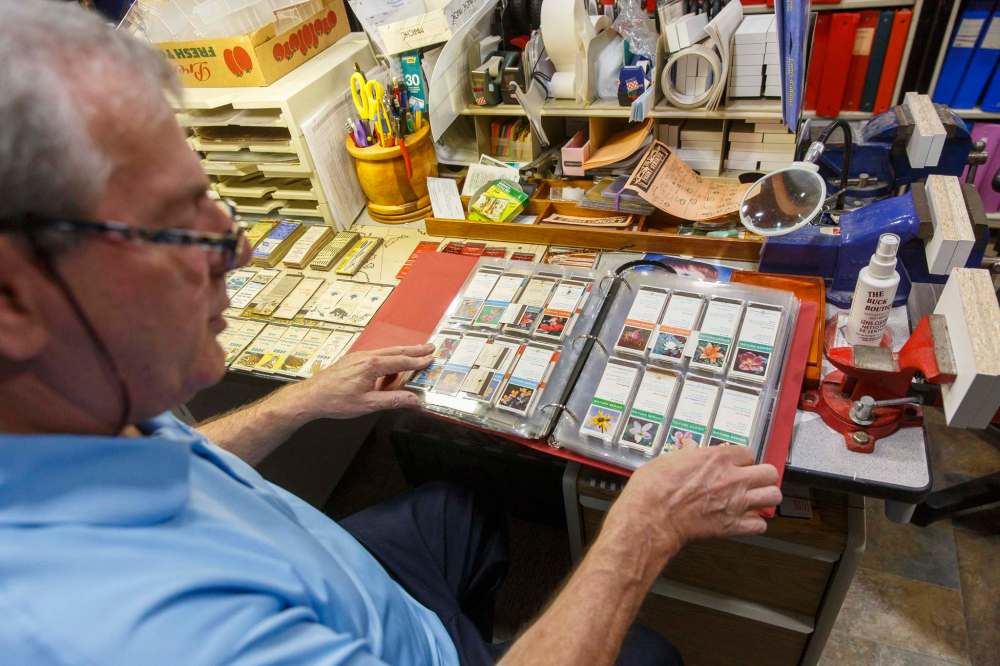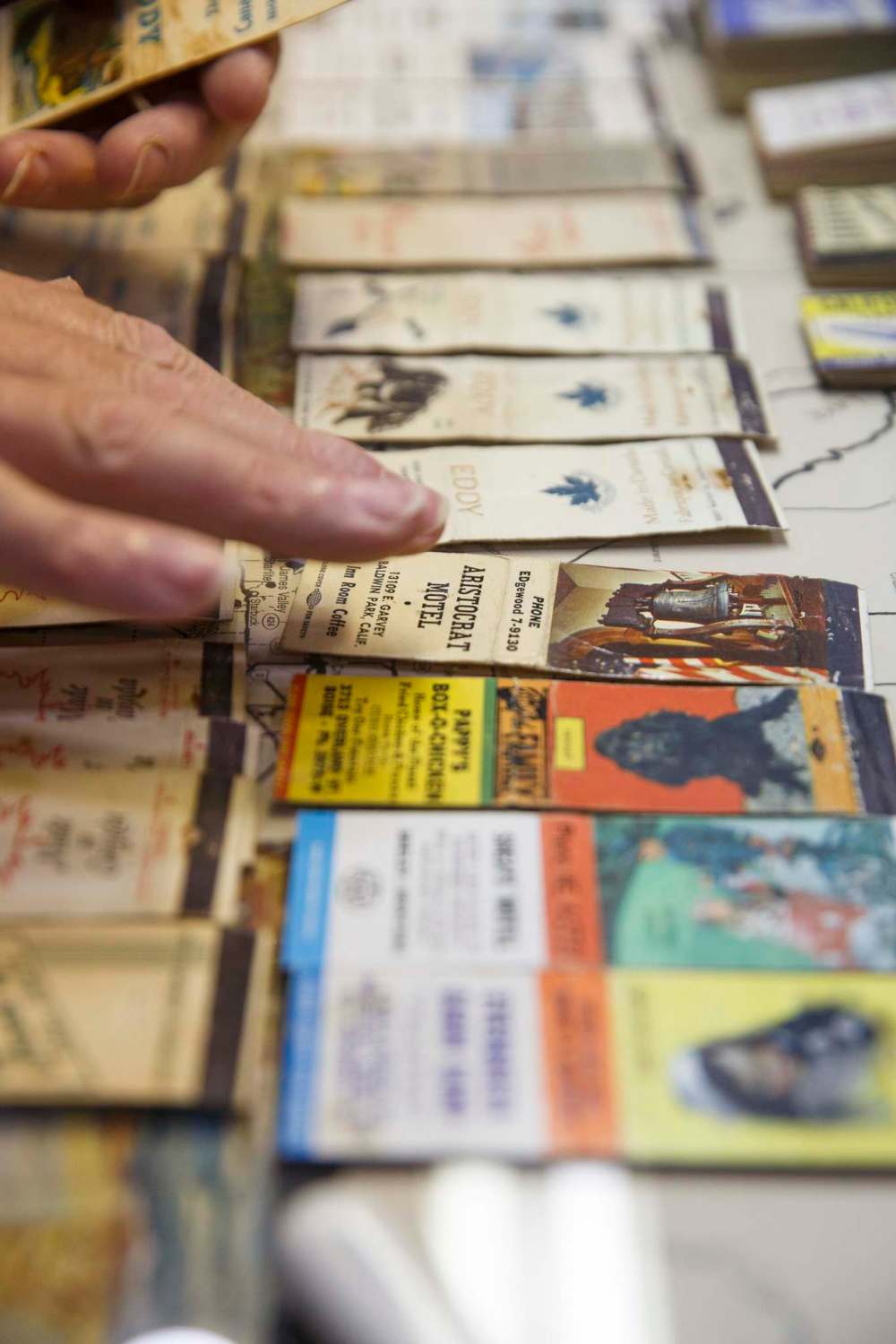Match game For these collectors, it's fine to judge a book by its cover
Read this article for free:
or
Already have an account? Log in here »
To continue reading, please subscribe:
Monthly Digital Subscription
$0 for the first 4 weeks*
- Enjoy unlimited reading on winnipegfreepress.com
- Read the E-Edition, our digital replica newspaper
- Access News Break, our award-winning app
- Play interactive puzzles
*No charge for 4 weeks then price increases to the regular rate of $19.00 plus GST every four weeks. Offer available to new and qualified returning subscribers only. Cancel any time.
Monthly Digital Subscription
$4.75/week*
- Enjoy unlimited reading on winnipegfreepress.com
- Read the E-Edition, our digital replica newspaper
- Access News Break, our award-winning app
- Play interactive puzzles
*Billed as $19 plus GST every four weeks. Cancel any time.
To continue reading, please subscribe:
Add Free Press access to your Brandon Sun subscription for only an additional
$1 for the first 4 weeks*
*Your next subscription payment will increase by $1.00 and you will be charged $16.99 plus GST for four weeks. After four weeks, your payment will increase to $23.99 plus GST every four weeks.
Read unlimited articles for free today:
or
Already have an account? Log in here »
Hey there, time traveller!
This article was published 13/11/2020 (1850 days ago), so information in it may no longer be current.
When you’ve been writing about collectors and their various treasures for 17-odd years, your inbox can get rather… interesting at times.
Case in point: a few weeks back we received an email from a Free Press subscriber whose wife was torn over what to do with a mishmash of nostalgic objects she’d kept stored in the garage for years, mostly because she didn’t have the heart to toss them out with the trash.
The missive read, in part: “Hi David. I seem to recall you doing a story on someone who collects old matchbooks and it turns out (spouse’s name removed) has a few hundred she would like to give away. Do you know someone who would like these?”
First of all, our contact has a long memory. Yes, we did put together a story about a phillumenist, or matchbook collector, in July 2007, a person whose sole focus was matchbook covers boasting logos of Winnipeg bars and restaurants from yesteryear.
But no, we were forced to reply, we no longer had that person’s contact information, nor were we familiar with anybody else who collects matchbooks, a brand of advertising that was ubiquitous in the first half of the 20th century, then steadily declined, largely due to anti-smoking campaigns combined with the 1973 invention of the BIC lighter.
That all changed after we dug around a bit and turned up Morris Pasternak, president of the Ontario-based Trans-Canada Matchcover Club, the country’s foremost matchbook collecting organization.
Within a few hours Pasternak put us in touch with Denis Bouchard, a lifelong resident of St. Adolphe and the lone Manitoban in the group.
When we caught up with Bouchard a few days later, he was only too happy to take those hundreds of matchbooks off that reader’s wife’s hands.
●●●

“OK, let’s see what we have here,” Bouchard says, spreading his new gifts, which include matchbooks touting such long-gone, local haunts as Underground Pizza Works, Moskovitz & Moskowitz, Garden Creperie and the K-Tel Motor Inn, out on a table in the basement.
“Everything looks pretty interesting but it might take me a while to figure out which ones I have or don’t have, already.”
He can say that again. The walls of the downstairs office he devotes to his cache are lined with rows of shelves burdened with dozens of three-ring binders and photo albums, each of which contains hundreds of matchbook covers dating as far back as the 1930s and ‘40s.
Just how many matchbooks does Bouchard have? Good question, he responds. Although he guesstimates the ever-changing total is somewhere in the tens of thousands, he’s never taken the time to tally the lot up because “that would spoil all the fun.”
(Oh, in case you’re reaching for the phone to call the fire department, don’t bother. The very first thing matchbook mavens such as Bouchard do when they bring fresh specimens home is remove and carefully discard the matches, leaving the cover intact.)
Bouchard, 67, got into the hobby innocently enough. At age 13 he landed a part-time job at St. Adolphe’s lone grocery mart, where he was invited to help himself to giveaway matchbooks featuring images of birds and flowers on the covers.
“I’d never collected a thing before — not hockey cards, not comic books — but for whatever reason, those (matchbooks) kind of caught my eye and every time a new one came out, I’d bring it home and throw it in an old shoebox, along with the others,” he says.

Bouchard, a father of three, continued collecting through the years but took a break from the hobby when he and his wife started a family.
After their kids got a bit older, however, he started anew by piling everybody into the car every July to spend a few weeks criss-crossing the continent, hitting various matchbook collector conventions along the way.
While his wife and children made good use of the hotel pool, he spent his days holed up in one banquet room or another, selling and trading matchbook covers with people “who spoke the same language.”
A match made in heaven
wfpsummary:Joshua Pusey, a Philadelphia lawyer who loved a good cigar, is credited with inventing the first matchbook in 1892. A few years later, a person associated with a New York City opera house came up with the bright idea of advertising future performances by handwriting dates and location on the covers of matchbooks, which were initially blank.:wfpsummary
Joshua Pusey, a Philadelphia lawyer who loved a good cigar, is credited with inventing the first matchbook in 1892. A few years later, a person associated with a New York City opera house came up with the bright idea of advertising future performances by handwriting dates and location on the covers of matchbooks, which were initially blank.
Soon, Ohio-based Diamond Match Company, which had purchased the rights to Pusey’s invention for $4,000, was pushing matchbooks as “mini-billboards.” The Pabst Brewing Company was reportedly the first conglomerate to hop aboard, ordering 10 million matchbooks for advertising purposes in 1896. Within 20 years, the matchbook was the most popular form of advertising in North America, according to the book Match Covers, A Guidebook for Collectors (1976), by Esther Rancier.
Here’s something interesting: in the 1930s, a home correspondence course called Art Instruction Inc. began issuing matchbooks reading, “You are in demand if you can draw! Make money with your brush and pen.”
One of the millions of people who signed up for the course after reading about it on a matchbook was a Minneapolis youth named Charles M. Schulz who, as most people are well aware, went on to create the Peanuts comic strip.
— David Sanderson
Bouchard, who was attending a matchbook convention in Tampa Bay in March when the federal government advised Canadians vacationing abroad to consider returning home as soon as possible owing to COVID-19, currently spends the majority of his free time fine-tuning his horde.
Once the matches have been extracted, he inserts the cardboard covers into a vice, as many as 50 at a time, for a few hours to flatten the folds.
Then the real work begins: deciding what category individual covers fall under.
How specific do things get? Well, in addition to binders generically marked “hotels and motels,” he also has three albums reserved strictly for matchbooks from Holiday Inns, and another three for Best Westerns.
Things are equally definitive when it comes to the animal kingdom; a middle shelf boasts binders carrying spine labels such as “bears,” “horses,” “dogs,” even “chickens.”
(Before retiring he was in the poultry business for close to 30 years, he explains, when asked what would ever possess a person to amass close to 1,000 matchbooks depicting barnyard fowl.)

“I also grab anything I see that has my name on it,” he continues, pointing out covers marked Bouchard Tavern, Bouchard Drive-in and Bouchard’s Mixed Drinks & Good Food, the latter of which was located in Standish, Calif.
“One time I tried to trade a guy five (matchbooks) for one, when I noticed he had a cover stamped Denis something-or-other. Except when I told him that was my name he tossed it to me saying, ‘I don’t want anything for it, it’s all yours.’”
For his part, Pasternak, 73, started collecting matchbook covers in the early 1980s. His mother used to have an oversized brandy snifter stuffed with matchbooks.
One day, when she noticed him pilfering ones that caught his eye, she told him, “Hey, get your own.”
Fifty thousand matchbook covers later, Pasternak currently specializes in a variety of genres, including sports, English royalty, alcohol and terrorists.
Err, pardon me? Terrorist matchbooks?

“That’s right,” he says, when reached at home in Richmond Hill, Ont. “We know of 78 different covers and boxes. The majority were issued by the United States Department of State under their Rewards For Justice program and distributed all over the Middle East.”
(True that; a cover with a photo of former Iraqi despot Saddam Hussein reads, “You deliver, we pay,” and offers a $30-million reward, while also reminding the person in possession of the matchbook to, “Be safe, keep cover closed.”)
When it comes to value, people are often surprised to discover how much certain Holy Grail-type matchbooks are worth, Pasternak says, especially considering the overwhelming majority were initially free for the taking.
“The hobby’s most cherished matchbook was issued to commemorate Charles Lindbergh’s (1927) flight across the Atlantic,” he continues.
“The hobby knows of very few that have survived the almost 100 years since their issue. In 1993, at the Rathkamp Matchcover Society convention in Cleveland, one sold for $4,000. It was reported that in 2015 another sold for $6,000.”
Back in St. Adolphe, Bouchard, an ex-smoker, says that for him, collecting matchbooks has never been about trying to make money off his collection, but rather about the bonds he’s built with like-minded people.
If 2020 had been a “normal” year, he would have hit at least a half-dozen conventions by now, hooking up with many of the same faces at each get-together.

“I belong to almost every group in North America and at 67, I’m considered one of the young guys,” he says with a chuckle. “And because most of us who collect matchbooks are up there in years, it presents a bit of a problem.
“My kids aren’t interested in my stuff and the same goes for most collectors. That’s why I often get notified when a group member passes on, and the family wants to know if I want the covers. They know I’m not going to turn around and sell them, but rather give them a good home.”
david.sanderson@freepress.mb.ca
Dave Sanderson was born in Regina but please, don’t hold that against him.

Mike Deal started freelancing for the Winnipeg Free Press in 1997. Three years later, he landed a part-time job as a night photo desk editor.
Our newsroom depends on a growing audience of readers to power our journalism. If you are not a paid reader, please consider becoming a subscriber.
Our newsroom depends on its audience of readers to power our journalism. Thank you for your support.






